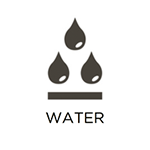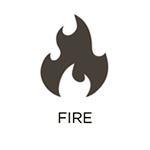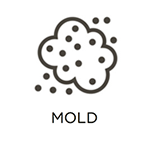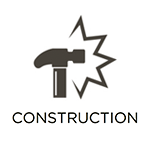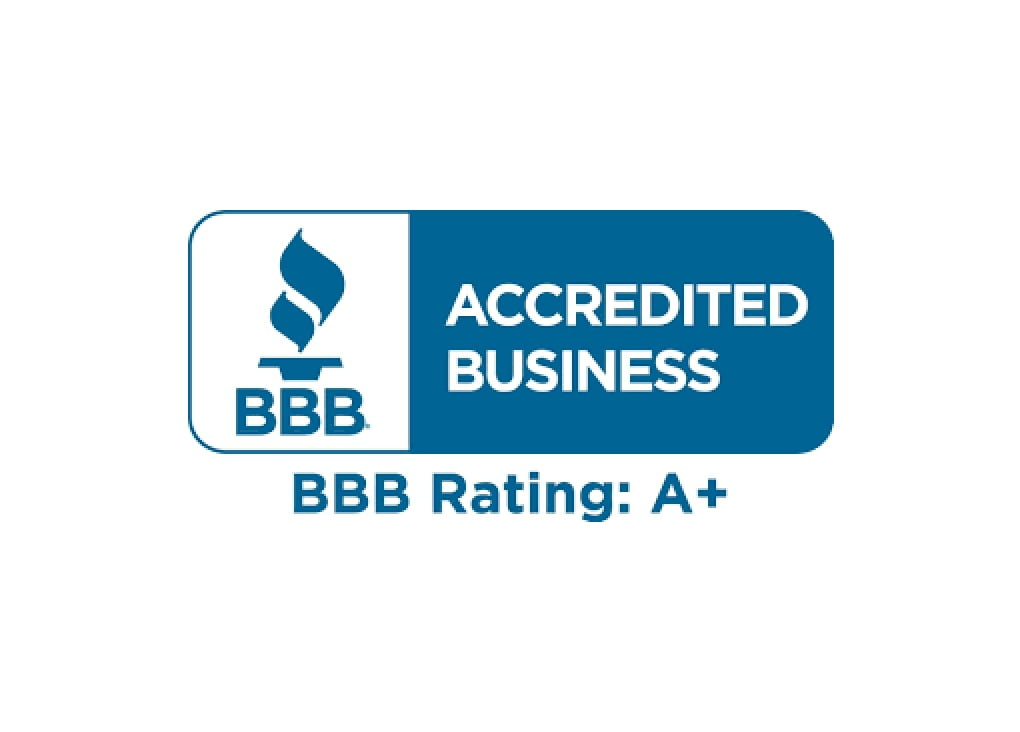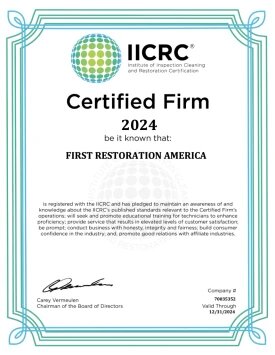First Restoration America
A flood situation can occur due to various reasons, including heavy rainfall, overflowing rivers, melting snow, burst pipes, or sewage backups. When water levels exceed their normal limits, it can cause significant damage to homes, infrastructure, and personal belongings. Floods can bring a range of risks into your home. They can weaken the structure, potentially leading to collapse, and damage electrical systems and appliances, increasing the risk of shocks or fires. Floodwaters often carry harmful contaminants like bacteria and chemicals, posing health risks if not properly cleaned. Mold and mildew growth can worsen health issues and damage property. Additionally, standing water attracts pests, making the situation more complicated.
First Restoration America provides flood cleanup services to homes and businesses in Charlotte, North Carolina, and the surrounding areas. Our experts are certified by the Institute of Inspection, Cleaning and Restoration Certification (IICRC) and are extensively trained in water damage restoration, specializing in treating crawl space flooding or bathroom flooding. To excel in the job, we use the most advanced cleaning products, procedures, and equipment for effective cleanup.
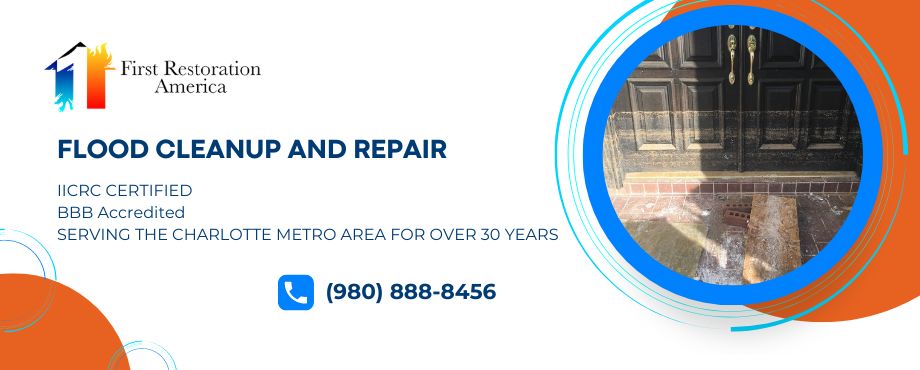
Hurricane Storm and Flood Events in Charlotte, NC
Tropical Storm Irma brought heavy rains to the Charlotte area in September 2017. The storm’s effects included extended periods of rainfall and gusty winds.
In September 2018, the remnants of Hurricane Florence, which made landfall in North Carolina as a major hurricane, brought significant rainfall to Charlotte. Although the city did not experience the hurricane’s full force, the heavy rains caused considerable flooding in low-lying areas and along streams and rivers, damaging infrastructure and properties.
Earlier, in April 2019, a series of storms caused heavy rains in Charlotte, resulting in rising water levels in local rivers and streams. This led to damage to homes, businesses, and roads, with some areas experiencing prolonged standing water.
In July 2020, intense rainfall struck Charlotte, with some areas receiving over 3 inches of rain in a short period. This led to localized flooding and impacts on infrastructure. Several roads were closed, and there were reports of property damage as emergency services responded to affected areas.
In August 2021, Charlotte was hit by heavy rain from Tropical Storm Fred, resulting in widespread flooding. Rainfall rates exceeded 2 inches per hour, causing flash floods across various parts of the city, particularly affecting areas near the Catawba River and its tributaries. This flooding led to road closures, property damage, and disruptions in some neighborhoods.
When there is any indoor flooring after any hurricane, storms , or tornadoes, We’re ready to help for the cleanup and repair.
Major Flood Zones in Charlotte, NC
In Charlotte, NC, major flood zones are typically identified through FEMA’s Flood Insurance Rate Maps (FIRMs). The areas prone to flooding are categorized into different flood zones. Here are some of the notable flood zones and areas in Charlotte:
- Flood Zone A: Areas that are at high risk for flooding but have no base flood elevation determined. This zone includes parts of East Charlotte and neighborhoods near the Catawba River and Little Sugar Creek.
- Flood Zone AE: Areas where base flood elevations are determined. This zone often includes areas along the larger rivers and creeks, such as the Catawba River, and parts of the South End and North End neighborhoods.
- Flood Zone X: Areas with a moderate to low risk of flooding. While not as high-risk as zones A and AE, this zone includes regions in the outskirts of Charlotte and some suburban areas.
- Flood Zone AH: Areas with shallow flooding, often with ponding of water. This zone can include low-lying areas and places where drainage is poor.
When your Basement Floods, Call First Restoration America
Basement flooding is a typical worry among homeowners, often arising from several factors. This could be sump pump failure, gutter overflow, or structural vulnerabilities such as holes in basement walls that is leaking the outside water into the basement. Additionally, if the laundry room is in the basement, there’s a higher risk of flooding if a pipe bursts. These situations highlight how vulnerable basements are to water damage.
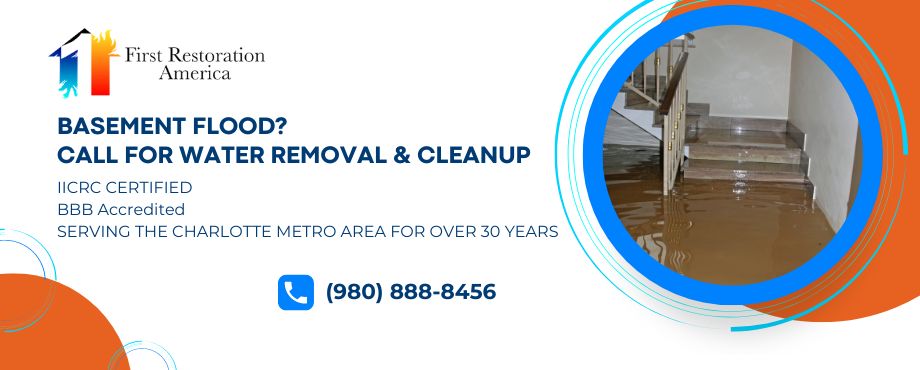
If you suspect water pooling in your basement, contact First Restoration America immediately. As part of our basement flood cleanup process, we extract the standing water from the property. Then, we thoroughly scrub all areas and surfaces, including hard-to-reach places behind and under appliances. We use industrial air movers and dehumidifiers to dry out the basement and affected materials.
Flood Cleanup in Charlotte, North Carolina
First Restoration America is the trusted flood cleanup expert in the entire state of North Carolina. We are locally owned experts and have been in this industry for more than 30 years. Additionally, we are certified by IICRC and licensed.
Our flood damage restoration process includes:
- Inspection and Assessment: Upon arrival, our experts conduct a thorough inspection to assess the extent of the damage and identify any potential hazards, providing a free estimate.
- Water Mitigation: We use powerful pumps and vacuums to remove standing water from affected areas.
- Anti-Microbial Application: To remove mold and bacteria growth, we apply anti-microbial solutions to sanitize the affected surfaces.
- Drying-Air movement: We use high-powered air movers to promote air circulation and accelerate the drying process.
- Drying-Dehumidifying: In conjunction with air movers, we use advanced dehumidifiers to extract excess moisture from the air, helping to maintain optimal humidity levels and further expedite drying.
- Monitoring: Throughout the drying process, we continuously monitor humidity levels and moisture content using specialized equipment.
Flood Damage Repair in Charlotte
Leaky roofs or ceilings and standing water can cause significant damage to your flooring, carpets, drywall, or walls. This damage may appear as water stains, discoloration, squeaky sub floors, weakened ceilings, and warping or bubbling paint on walls. Our flood damage repair services involve replacing and rebuilding any affected building materials to address these issues. Neglecting these repairs could result in further deterioration and more extensive damage over time.
What to Do After Flood Damage
If a flood should occur in your home or business, call the First Restoration America immediately to begin the water damage restoration process. After placing the call, perform the following actions before our technicians arrive:
- Mop or blot dry to soak up excess water.
- Wet area rugs and floor coverings should be removed.
- Keep draperies off the floor by putting the bottoms through a coat hanger and putting the hanger on the drapery rod.
- Wipe down wet furniture and prop up the cushions, put aluminum foil under furniture legs.
- Remove photos and paintings and store them somewhere safe.
- Keep all drawers, doors, and closet and cabinet doors open to help the drying process.
What NOT to Do After Flood Damage
- Do not enter a flooded room while the power is on.
- Do not try to remove water with a regular vacuum cleaner.
- Do not remove permanent carpeting without the help of a professional.
- Do not use electrical appliances while standing on a wet floor.
- Do not clean up visible mold growth.
- Do not take wet books of their shelves; instead pack them together tightly to keep the pages from warping until they can be properly treated.
Call us for Flood Cleanup and Repair in Charlotte, NC
If you have experienced flooding in your home or business in Charlotte, NC, do not hesitate to contact First Restoration America at (980) 888-8456 for flood cleanup services. Our phone lines are open 24 hours a day, 7 days a week for quick response to flood repair emergencies.
Commonly Asked Questions About Flood Restoration
Q. Who is responsible for flood damage? Landlord or Tenant?
Landlords are usually responsible for maintaining the property and fixing issues that cause flooding. However, if a tenant’s actions lead to flooding, they may be held responsible. For example, tenants are liable for water damage resulting from negligence, such as leaving faucets open or causing water pipes to burst. In these cases, the tenant must cover the repair costs.
Q. How to remove musty smell from basement after flooding?
A musty smell after a flood can indicate the presence of mold and mildew. To remove this odor, use dehumidifiers, cat litter, or baking soda to absorb the moisture and any residual smells.
Q. How to dry flooded carpet?
To dry a flooded carpet, start by using a wet/dry vacuum to remove water. Then, lift the carpet to let air circulate underneath and remove the wet padding. Use fans and dehumidifiers to dry the carpet faster. Open windows for ventilation if possible.
Q. How long does it take for flood water to clear?
Flash floods usually go away in hours, but natural floods can stick around for days or even weeks. If a flood is caused by a clogged or damaged drain, it might keep coming back until the drain is fixed.
Helpful Resources
Does Flood Insurance Cover Burst Pipes?
Flood insurance does not cover burst pipes unless the burst is a direct result of a flood. Flood insurance is designed to cover damage caused by rising water levels from natural events like heavy rain, storm surges, or overflowing rivers. Burst pipes are usually covered under a separate policy, such as homeowners insurance.
How are Floods Measured?
Floods are measured in different ways to keep track of water levels and flow rates. River gauges are set up along rivers and streams to give real-time updates on how high the water is. Rain gauges help measure how much rain has fallen in a specific area. Remote sensing tools, like satellites and radar systems, keep an eye on flood-prone regions by monitoring rainfall intensity and soil moisture levels. By pulling together information from these sources, authorities can get a clear picture of floods, issue warnings, and take steps to keep people and property safe.
Recent Reviews
Dan Davoli

"I’m thrilled with the work done by First Restoration. The crew was punctual, professional, clean, and the project started and ended when they said it would! The price for my remodel was very competitive, and there were no “surprises” along the way. Within 2 days of the project being completed, I received a call from the owner of the company asking if I needed anything else, and if I was satisfied. I appreciated the personal touch and desire to ensure I was satisfied with their work product. 5 stars!"
Kevin Norton

"First restoration was great. I had a leak from an upstairs washer. Keith answered my call right away. Employees arrived a few hours after my call and set up the fans and dehumidifier. First restoration was great and would strongly recommend them in the future."
Judy Hudson

“Fortified with a sense of humor, First Restoration was able to come into my home during some really tough times. They not only helped me when I needed them most following Hurricane Matthew but were also reliable and honest about their work- completed in timely manner too! Plus they have this great attitude that makes you want them on every project from hereon out... I would highly recommend using these guys if anyone wants an excellent restoration service done right”
See All Reviews


